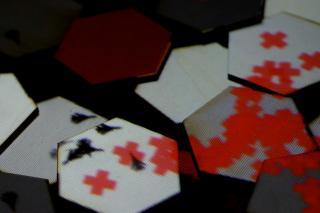Peter Holzkorn
Peter Holzkorn
A projection mapping on hexagonal tiles that mixes the iconography of strategy war games and audio fragments of real conflict to explore the idea of games as abstracted, idealised versions of unfair and ambiguous real-life struggle.

Classes
Video Sculpture
Video Sculpture
"The military entertainment complex would like to believe, and would like you to believe, that gamespace [the author's term for the 'real world', P.H.] is not a Nietzschian struggle of naked forces, beyond good and evil, but a clean, well lighted, rule-governed game." -McKenzie Wark, Gamer Theory
Games always abstract from and simulate aspects of real processes. It is important that we don't mistake those abstractions for reality (which is a "broken game" by the standards of balance required for playable games), and that we keep in mind that the violence in the aesthetics of games is far less relevant than the conceptual models we derive from its rules and mechanics.
The setup:
Hexagonal tiles (a favourite shape for strategy games due to a certain advantage over the square grid) with a 10cm diameter are arranged in a "disrupted" grid, overlapping each other etc. The viewer can use a joystick to navigate through the tiles, highlighting one at a time. A tile that is highlighted will trigger a synthesized voice to speak a fragment of a speech used to incite a real war, followed by a movement of game-like units across the map, looking for other units to engage with. The use can explore the space, causing more and more movement and (ultimately) destruction.
The visuals are created via projection mapping onto individual wooden tiles. Ideally, the viewer should be unclear about whether the spoken words are "real" or not (they are) and whether the movements across the map correspond to "real" data (they don't).
Dimensions: About the size of the black lounge tables, plus a pedestal for the joystick. Should be rather dark and quiet.
User Scenario
The viewer approaches the game map. The joystick is positioned so that it affords use. By using it, a highlight is moved across the tiles. Where the user stops the highlight for several seconds, an action is triggered: An audio sample is played, followed by a dynamic rule-based movement of units across the map. If other units are present from a previous triggering, the units react to each other. Eventually the units are destryed or get lost and disappear.
The goal is to get the viewer to think about the confusion of the perfect geometry and clear rules of games with the unclear rules and motivations embodied in this "game".
Games always abstract from and simulate aspects of real processes. It is important that we don't mistake those abstractions for reality (which is a "broken game" by the standards of balance required for playable games), and that we keep in mind that the violence in the aesthetics of games is far less relevant than the conceptual models we derive from its rules and mechanics.
The setup:
Hexagonal tiles (a favourite shape for strategy games due to a certain advantage over the square grid) with a 10cm diameter are arranged in a "disrupted" grid, overlapping each other etc. The viewer can use a joystick to navigate through the tiles, highlighting one at a time. A tile that is highlighted will trigger a synthesized voice to speak a fragment of a speech used to incite a real war, followed by a movement of game-like units across the map, looking for other units to engage with. The use can explore the space, causing more and more movement and (ultimately) destruction.
The visuals are created via projection mapping onto individual wooden tiles. Ideally, the viewer should be unclear about whether the spoken words are "real" or not (they are) and whether the movements across the map correspond to "real" data (they don't).
Dimensions: About the size of the black lounge tables, plus a pedestal for the joystick. Should be rather dark and quiet.
User Scenario
The viewer approaches the game map. The joystick is positioned so that it affords use. By using it, a highlight is moved across the tiles. Where the user stops the highlight for several seconds, an action is triggered: An audio sample is played, followed by a dynamic rule-based movement of units across the map. If other units are present from a previous triggering, the units react to each other. Eventually the units are destryed or get lost and disappear.
The goal is to get the viewer to think about the confusion of the perfect geometry and clear rules of games with the unclear rules and motivations embodied in this "game".

